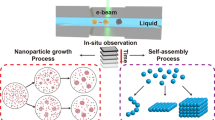Abstract
A disorderly nanostructured CdSe nanoagglomerates (NAs) with tunable emission are synthesized in aqueous solution. Although the CdSe NAs have diameters of about 20 nm that are larger than the Bohr radius of the crystal bulk, they show size-dependent emission similar to the CdSe nanocrystals. The CdSe NAs represent a collective energy state based on Anderson localization.
Similar content being viewed by others
References
Alivisatos A P. Perspectives on the physical chemistry of semiconductor nanocrystals. Journal of Physical Chemistry, 1996, 100(31): 13226–13239
Nirmal M, Brus L E. Luminescence photophysics in semiconductor nanocrystals. Accounts of Chemical Research, 1999, 32(5): 407–414
Maillard M, Motte L, Ngo A T, Pileni M P. Rings and hexagons made of nanocrystals: a marangoni effect. Journal of Physical Chemistry B, 2000, 104(50): 11871–11877
Yang Y, Chen O, Angerhofer A, Cao Y C. Radial-positioncontrolled doping in CdS/ZnS core/shell nanocrystals. Journal of the American Chemical Society, 2006, 128(38): 12428–12429
Kovalev D, Heckler H, Polisski G, Koch F. Optical properties of Si nanocrystals. Physica Status Solidi, 1999, 215(2): 871–932
Qu L, Yu W W, Peng X. In situ observation of the nucleation and growth of CdSe nanocrystals. Nano Letters, 2004, 4(3): 465–469
Chan W C W, Nie S. Quantum dot bioconjugates for ultrasensitive nonisotopic detection. Science, 1998, 281(5385): 2016–2018
Murray C B, Norris D J, Bawendi M G. Synthesis and characterization of nearly monodisperse CdE (E = sulfur, selenium, tellurium) semiconductor nanocrystallites. Journal of the American Chemical Society, 1993, 115(19): 8706–8715
Murray C B, Kagan C, Bawendi M G. Synthesis and characterization of monodisperse nanocrystals and close-packed nanocrystal assemblies. Annual Review of Materials Research, 2000, 30(1): 545–610
Sadasivuni K K, Kafy A, Zhai L, Ko H U, Mun S, Kim J. Transparent and flexible cellulose nanocrystal/reduced graphene oxide film for proximity sensing. Small, 2015, 11(8): 994–1002
Christopher Doty R, Yu H, Shih C, Korgel B. Temperaturedependent electron transport through silver nanocrystal superlattices. Journal of Physical Chemistry B, 2015, 105(35): 8291–8296
Stephen C, Stephen F, Brian K, Donald F. Time-resolved smallangle X-ray scattering studies of nanocrystal superlattice selfassembly. Journal of the American Chemical Society, 2015, 120(12): 2969–2970
Jia T, Kolpin A, Ma C, Chan R C, Kwok W M, Tsang S C. A graphene dispersed CdS-MoS2 nanocrystal ensemble for cooperative photocatalytic hydrogen production from water. Chemical Communications, 2014, 50(10): 1185–1188
Artemyev M V, Bibik A I, Gurinovich L I, Gaponenko S V, Jaschinski H, Woggon U. Optical properties of dense and diluted ensembles of semiconductor quantum dots. Physica Status Solidi, 2001, 224(2): 393–396
Artemyev M V, Woggon U, Jaschinski H, Gurinovich L I, Gaponenko S V. Spectroscopic study of electronic states in an ensemble of closeccacked CdSe nanocrystals. Journal of Physical Chemistry B, 2000, 104(49): 11617–11621
Ge J P, Li Y D, Yang G Q. Mechanism of aqueous ultrasonic reaction: controlled synthesis, luminescence properties of amorphous cluster and nanocrystalline CdSe. Chemical Communications, 2002, 17(17): 1826–1827
Ma X D, Qian X F, Yin J, Xi H A, Zhu Z K. Preparation and characterization of polyvinyl alcohol-capped CdSe nanoparticles at room temperature. Journal of Colloid and Interface Science, 2002, 252(1): 77–81
Zhu J, Xu S, Wang H, Zhu J, Chen H. Sonochemical synthesis of CdSe hollow spherical assemblies via an in-situ template route. Advanced Materials, 2003, 15(2): 156–159
Mott N F, Davis E A. Electronic Processes. In: Non-Crystalline Materials. 2nd Edition, Oxford: Clarendon Press, 1979
Anderson P W. Absence of diffusion in certain random lattices. Physical Review, 1958, 109(5): 1492–1505
Zhong L W, Steven A H, Igor V, Robert L W, James B, Neal D E, Kathy B A. Superlattices of self-assembled tetrahedral Ag nanocrystals. Advanced Materials, 2010, 10(10): 808–812
Ma Q, Xiong R, Huang Y M. Tunable photoluminescence of porous silicon by liquid crystal infiltration. Journal of Luminescence, 2011, 131(10): 2053–2057
Swart I, Liljeroth P, Vanmaekelbergh D. Scanning probe microscopy and spectroscopy of colloidal semiconductor nanocrystals and assembled structures. Chemical Reviews, 2016, 116(18): 11181–11219
Acknowledgements
We thank the National Natural Science Foundation of China for financial support of this research (Grant No. 21673167).
Author information
Authors and Affiliations
Corresponding author
Additional information
Ruiqing Hu is now a research assistant at Wuhan Textile University. She obtained her B.S. and M.S. degrees under the supervision of Prof. Weilin Xu and Prof. Haifeng Bao in materials science and engineering in Wuhan Textile University. Her research focuses on luminescent semiconductor materials synthesis and processing.
Yifeng Shi received his Ph.D. degree in physical chemistry from Fudan University (2007). In 2007–2010, he was a research associate in the University of California at Santa Barbara. In 2010–2014, he was a Professor of materials chemistry in Hangzhou Normal University, working on mesoporous materials for energy and environmental science. He is now a guest professor in the Wuhan Textile University.
Haifeng Bao received his B.S. degree from Wuhan University in 1997. Then he studied with Prof. Erkang Wang (academician of Chinese Academy of Science) at Changchun Institute of Applied Chemistry, Chinese Academy of Sciences, where he received his Ph.D. degree in analytical chemistry in 2005. From 2006 to 2008, he worked as a research fellow in Nanyang Technology University with Prof. ChangMing Li. From 2008 to 2010, he worked as a postdoctoral research fellow in Monash University with Prof. Dongyuan Zhao. He worked as a professor in Hangzhou Normal University from 2010 to 2013. Now, he is a distinguished professor of Chutian Scholar Program at the School of Material Science and Engineering, Wuhan Textile University. His research is mainly focused on the synthesis and application of the photoelectric nanomaterials.
Rights and permissions
About this article
Cite this article
Hu, R., Shi, Y. & Bao, H. Luminescent disordered nanostructures: synthesis and characterization of CdSe nano-agglomerates. Front. Optoelectron. 11, 385–393 (2018). https://doi.org/10.1007/s12200-018-0822-0
Received:
Accepted:
Published:
Issue Date:
DOI: https://doi.org/10.1007/s12200-018-0822-0




